
The Gardens at Parrot Jungle Island, The First Year

Parrot Jungle Island had its first year anniversary during the month of June 2004. This was a good time to reflect upon the progress of this “built from scratch” garden and review the means and methods of the horticultural decisions that were made during the two-year process of landscape installation.
The design of this 18 acre garden was based upon a number of factors. Successful horticulture programs had been developed at Parrot Jungle & Gardens (PJG) the original park site and the landscape design would accommodate and allow these programs to evolve given the unique nature of this new site.
Horticultural Programs
The Integrated Pest Management program (IPM) at PJG was developed over a period of 15 years and resulted in an insect control program that used a minimum of pesticides (none restricted). Biological controls were introduced with good results i.e. Nosema for Lubber Grasshopper control, Bacillus thuringiensis for chewing insects and mosquito control. The success of the IPM program was based upon another program, Plant Health Care (PHC) which utilized strict control of irrigation, the extensive use of park produced compost, constant mulching, and cultivation techniques.
The Soil
Watson Island is an 86 acre spoil island that was created in the first part of the last century when the ship channels for the adjacent Port of Miami were dug. The top 10 feet of this island consists of sand with varying amounts of shell or limestone fragments. The first 4 feet contains an organic component of up to 13% that has accumulated over time on the island through the natural decomposition processes that accompany the growth of vegetation or naturally occurring ground cover. The site was approximately 8 feet above sea level. Since Watson Island is classified as a flood zone, buildings are mandated to be built at 12 feet above sea level. This necessitated the importation of almost 27,000 tons of structural fill to be placed under all of the park’s structures. Before the structural fill was placed, the existing fill was removed down to 4 feet above the water table and stockpiled to be used as landscape soil.
The indigenous soil was used as a landscaping medium for several reasons; the island never seemed to flood in a heavy rain therefore it had excellent drainage characteristics, with excellent drainage come excellent aeration, many different species of trees and palms were successfully growing in this soil already, and when a different soil type is layered onto another soil type a perched water table can be created that will not allow water percolation to take place until the upper layer of soil is totally saturated. This can be deadly to many species of plants. Finally, the cost savings of not exchanging the landscape soil was tremendous.
The Compost
PJG had been a licensed composting facility that composted 100% of the park’s organic waste with the exception of food waste. This compost was then returned to the park as top soil and plant nursery soil media.
During the last two years at PJG more compost was made and stockpiled with the purpose of utilizing it at the new park to help establish the new landscaping. The compost license expired upon the sale of PJG and the rules of the licensing agency, Miami-Dade County Department of Environmental Resources Management (DERM) mandated that the compost be removed from the site. At this point we moved about 400 yards of this resource to the PJI site and began to use it as a soil conditioner and top-dressing.
The purpose of the compost use was to inoculate the soil with beneficial microorganisms and mycorrhiza (fungi that have a symbiotic relationship with roots) and to further add organic material to the existing soil to aid in moisture retention. The micro flora and fauna that occurs in the compost functions as a constant nutrient source to the plants but in small enough amounts that there is not a large “burst” of nitrogen into the plants that would merely serve to attract plant pathogenic insects. This is a very important part of reducing our reliance on pesticides and fertilizer.
Compost and mulch are also utilized to secure the sides of berms to prevent erosion allowing the eventual vegetative cover to do the work of artificial stabilizing materials. This application alone saved PJI approximately $60,000 by not having to install ground cloth and “rip-rap” (large rocks used to stabilize slopes).
Mulch
This is mulch derived from arborist tree trimming operations. Any clean mulch is accepted and used almost immediately as a ground cover. This mulch has several purposes; it has excellent aesthetic qualities, it holds down weeds, and it insulates the ground thereby reducing soil water evaporation. If the upper horizon of the soil is cool and moist there will be more beneficial organisms and tree root hairs in this zone. Mulch continues to decompose further adding organic material and nutrients to the soil. It also encourages earthworms to live in this zone that will improve soil aeration and further add more nutrients to the soil.
Green Mulch
Many landscape plants are short lived or need to be cut back on a regular basis. Certain plants accumulate nutrients that can be passed back into the soil when they are cut down and used as mulch. Leguminous plants accumulate nitrogen. Tithonia diversifolia, Mexican Daisy is a plant that accumulates phosphorous. When we cut back these plants, the resulting plant material is utilized as mulch and in the case of the Mexican Daisy it grows back as a nice landscape plant.
Irrigation
Without irrigation a collection of tropical plants will not grow and thrive at PJI; there is too much wind and of course heat. Irrigation is only done at night to reduce evaporation. The sprinklers themselves were specified to throw as large a droplet as possible. The larger the droplet of water, less actual surface area per droplet, and less evaporation per gallon of water; the droplet is also heaver and less wind throw will occur leaving fewer dryer landscape areas due to windy conditions.
There are several large water features at PJI and there is a mechanical filtration system to filter out organic mater etc. Instead of pumping out the resulting sludge and waste into a septic tank for off site removal, we pump the sludge into a “biofiltration” pond where the heavier sludge will precipitate out and the excess water is pumped back into the irrigation system. The sludge is periodically removed and used as a soil amendment.
There are areas of landscaping that were designed to have only temporary irrigation for a couple of years to get the plants established and growing. These plants once established will be able to live on rainwater and most likely will be taken off the irrigation system.
Water harvesting is also being considered for future irrigation use.
Cultivation Techniques
The selective pruning of leaves and inflorescences on many plants i.e. bananas, palms, Heliconias, is a proven way to mitigate insect pressure. Hand-picking leaves off Geiger trees that are full of Geiger Tortoise Beatle larvae is a more efficient, cost effective, and environmentally sound method of controlling these insects. There are many species specific ways to nurture plants that in the long run are more efficient and better for the environment.
Plant Selection
There are literally thousands of species of tropical plants that will grow at PJI. The key to the plant selection was utilizing plants that are native to areas with climatic and soil conditions similar to ours. This obviates the need for fertilizer. These plants normally grow very well under our composting and mulching regime. There would also be fast growing and usually short lived ( r-selected species) plants and trees that would be used to create an immediate canopy or vegetative barrier. Planted amongst these would be slow growing and long lived (k-selected species) plants and trees that in time would become the main horticultural component of the garden.
Canopy Trees
The site on Watson Island where PJI was constructed originally had about 150 trees growing on it. After a site analysis it was determined to save as many trees as possible by moving them off the site to a holding area and then back on as construction allowed. Of the original 150 trees, 80 were demolished due to poor trunk structure, extensive trunk damage or rot, or they were in the invasive exotics category. The 70 trees that remained were successfully moved offsite and then back on; a handful of trees were actually moved three times due to changes in site design. Now two years later we have had 100% success. The cost of moving and maintaining the full-size trees vs. transporting smaller trees (due to size regulations of moving them down a public thoroughfare) that have been pruned extensively and waiting years for a new canopy to grow has been very cost effective and productive in terms of creating a tree canopy for PJI as rapidly as possibly.
In the initial stages of construction a majority of the largest trees were replanted on the site and protected from the ongoing construction. These horticultural “islands” were also under-planted with smaller trees. These became field nurseries where we selected trees when needed. This worked out quite well because when a tree was moved it was out of the ground for only an hour or so reducing shock and damage to the tree.
Design and placement of the canopy trees was done along an east to west configuration and to the south of the concrete trails. This was done to provide shade to the park’s visitors and mitigate the summer “heat island” effect.
Grass and Lawns
There are two lawn areas at PJI; one is in Flamingo Lake and the other is our Picnic Lawn. This presents a number of issues. Flamingo Lake is a water exhibit with fish surrounded by lawn and trees with a flock of Flamingos. At issue is keeping the lawn healthy through a method that is safe for all the resident animals. The exhibit is in a basin and all chemicals used on the lawn will eventually run-off into the lake. The Picnic Lawn does not have animals but is used for picnics and other public events. A lawn and the underlying soil that is walked upon at times by hundreds of people is typically compacted by all the activity and is difficult to keep in good condition.
The issue of keeping the lawns green, disease free, and able to deal with soil compaction problems was resolved by utilizing what grows naturally on Watson Island and environs. There are many species of grasses and herbaceous plants that grow freely (some may call them weeds) in heavily trafficked areas and do quite well under this kind of pressure. Many of these plants are natural nitrogen fixers and look quite green. We have allowed these plants to grow into the lawns with very good results. Eventually after studying the growth habits of the different species we plan to select the best plants to grow and remove the others. The ability to grow a lawn that does not require spraying with pesticides or fungicides and that will not die under heavy foot traffic seems to be an attainable possibility.
The Results
Today through a holistic approach to landscape development PJI has successfully planted a garden. In the past year since PJI opened, the foliage and the tree canopy has grown many times over. We have been planting epiphytes; Staghorn ferns of several species, other species of ferns, and orchids are now established on our trees. We are increasing our collection of Heliconias, Bananas, Gingers, and Palms. An incredible collection of Cycads has been donated to us. These fossil plants are now in the garden successfully establishing themselves. Through better climatic conditions (the winter low temperatures are not as cold), better soil, and a more efficient landscape layout, the garden will rapidly mature and become a horticultural showcase.
Parrot Jungle Island is a GreenScapes Alliance member of the U.S. Environmental Protection Agency's Environmentally Beneficial Landscape program. This project has shown that a holistic approach to landscape site development is a very cost effective and environmentally sound method by which a facility can successfully establish a landscape or garden. Bottom line, it was worth it!
Copyright 2004 Jeff Shimonski




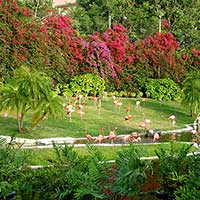




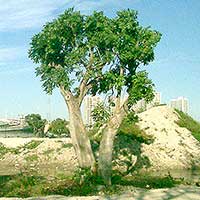
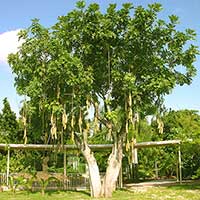
 About Theme Parks, Zoos & Tropical Design
About Theme Parks, Zoos & Tropical Design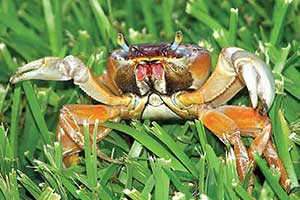 Integrated Pest Management in a Zoological Theme Park, Wing Beats the Journal of the American Mosquito Association
Integrated Pest Management in a Zoological Theme Park, Wing Beats the Journal of the American Mosquito Association The Environmental Lawn
The Environmental Lawn Design with Integrated Pest Management
Design with Integrated Pest Management Creating Islands in Aquatic Ecosystems
Creating Islands in Aquatic Ecosystems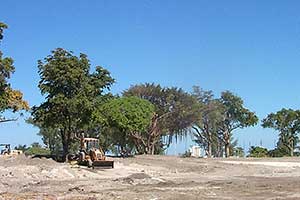 Building a New Jungle - Contouring the Site and Creating a Tree Canopy
Building a New Jungle - Contouring the Site and Creating a Tree Canopy Watson Island - Remaking History
Watson Island - Remaking History The Gardens at Parrot Jungle Island, The First Year
The Gardens at Parrot Jungle Island, The First Year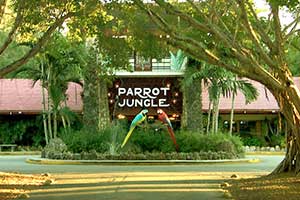 Parrot Jungle & Gardens
Parrot Jungle & Gardens